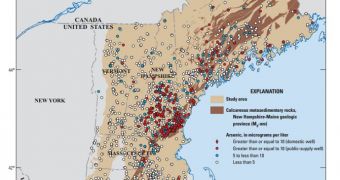A report recently posted online by the United States Geological Survey (USGS) indicates that groundwater in the state of New England contains potentially hazardous levels of naturally occurring arsenic, uranium, radium, radon and manganese.
All of these chemicals are very harmful to humans. They occur naturally at some locations, and are generally harmless, but can become a real public health problem once they start accumulating. What the new study found was that concentrations are currently so high that they can become dangerous.
Not all bedrock groundwater in New England is affected, researchers say, but those areas that are supply drinking water to a large number of wells. Private well owners in the state are encouraged to contact their State Drinking Water Programs, and ask for guidance and information about well maintenance.
The USGS had previous knowledge that arsenic existed in the waters tested during this study, but it was unaware that the other contaminants were also present. Most importantly, the study revealed the type of bedrock formation where these high concentrations of dangerous chemicals are most likely to occur.
Those who own wells need to start testing and treating their own water, if they want to continue using groundwater for drinking, cooking, gardening and agriculture. Otherwise, they risk becoming ill.
“The same geologic forces which gave rise to the spectacular mountains and architecturally significant rock quarries of New England are also responsible, over time, for leaching trace contaminants into the groundwater that can be harmful to human health,” USGS Director Marcia McNutt explains.
“This study helps focus attention on where and what the risk factors are such that citizens who depend on private wells can get their water tested to ensure peace of mind,” the top official goes on to say.
USGS experts found arsenic levels that far exceeded the federal safety standards for public drinking water currently in place. This situation was encountered at 13 percent of the sites analyzed. The amount of arsenic found in New England is nearly double the national rate.
“The concentrations above human health benchmarks and the wide variety of natural and man-made contaminants found show the vulnerability of crystalline rock aquifers that millions of people rely on to produce safe drinking water,” explains Sarah Flanagan, a scientist at the USGS and lead study author.
“The well-to-well variability of water quality from bedrock aquifers in the region underscores the importance of testing public and private wells individually,” she concludes.
The USGS report can be viewed here.

 14 DAY TRIAL //
14 DAY TRIAL //